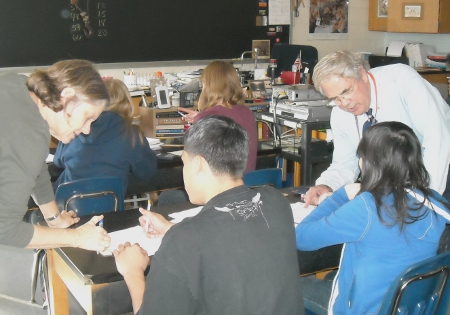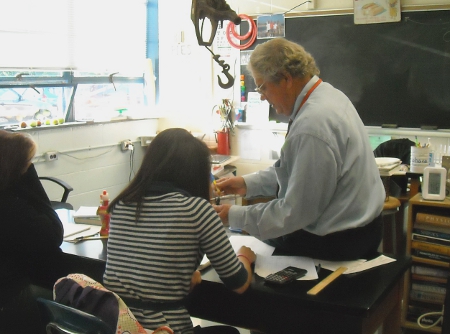Feature: A Team Approach to Special Needs
 Heater and Linz co-teach a class.
Heater and Linz co-teach a class.
Ed Linz, a physics teacher at West Springfield High School in Virginia since 1985, knows a thing or two about being part of a team. A naval officer for 20 years, he spent two of those years commanding the USS Kamehameha, a nuclear-powered submarine armed with ballistic missiles. Every time a submarine dives, crew members entrust their lives to the abilities of every other person on board.
This focus on trust and cooperation followed Linz into his second career as a teacher, from co-sponsorship of the school’s Science Honor Society to coaching the track and cross-country team and, most recently, to “team teaching” with special education teacher Mary Jane Heater.
The idea behind the Linz-Heater team is to pair a content-based teacher with a special ed. teacher in instructing a mixed group of students. That way, special education students have access to a general curriculum but can still receive extra help.
Heater had participated in such teams before, but found she was more often treated like an aide than a partner. With Linz, it was different. “Teaching with Ed is fantastic,” she says. “From the beginning he was interested in being a true team.” They worked so well together that they have collaborated on a manuscript for the National Science Teachers Association. It is intended as a guide to other teams, taking them through an entire school year.
The pair employs a variety of teaching techniques in hopes of reaching all of the students in the class, who learn at different paces and in different ways.
Their strategies include PIES (for Picture, Information, Equations and Solve-it), a systematic way to solve word and story-based problems. Students draw a picture and add in information from the word problem. Then, they create a “shopping list” of equations and use them to solve the problem.
 Most of Linz’s and Heater’s methods can be replicated in single-teacher settings. For instance, Linz holds students’ attention with humor and by relating some of his own life experiences. Concepts become easier to remember when accompanied by an amusing story.
Most of Linz’s and Heater’s methods can be replicated in single-teacher settings. For instance, Linz holds students’ attention with humor and by relating some of his own life experiences. Concepts become easier to remember when accompanied by an amusing story.
One of his story themes involves imaginary “heroic hamsters,” which have large objects dropped on them. A typical problem: “How much force must a heroic 6 cm tall hamster exert to stop a 5 kg block, which is dropped onto it from a height of 3.2 m? Assume that the final height of the hamster is 1.5 cm.”
Rather than just have an object or mechanism exert the force, the problem uses a hamster that heroically gets squished (hypothetically, of course) in the name of physics, and suddenly students are paying attention—and laughing. Moreover, the next time they come upon a problem like this, such as in college, they will remember that it is a “heroic hamster” problem, and feel confident in solving it, Linz says.
On his own, Linz also has his Honors students participate in the DuPont Challenge science essay contest. Tired of receiving science projects done at least in part by the students’ parents, he switched to the Challenge 4-5 years ago to give students the science writing experience they would need in STEM career fields. “I think writing is tremendously important in being a good engineer,” he says.
Linz takes each student through four drafts of the essay, which can be on any science topic, before the final drafts are sent to DuPont. He and the students go through the drafts together to make corrections. This simple but effective process, he says, is exactly what engineers use to solve problems. Last year, two of his students received honorable mentions for their contest submissions on nuclear power and coronary heart disease, respectively.
 Linz teaches his Active Physics class.
Linz teaches his Active Physics class.
As for running his class, Linz says the key is prioritizing and time management. Don’t let things like grading tests or writing college recommendation letters pile up. To avoid this, he always corrects tests and returns them the next day.
Linz, who had a full heart transplant back in 1994, is planning to retire at the end of the school year to spend more time writing about education. But, it seems his decision wasn’t an easy one. “I feel like I literally draw energy from these students,” he says.
Filed under: Special Features
Tags: Physical Science, Physics, Science Teachers, STEM education, Teachers, Team Teaching, Team-building skills, U.S. Navy








